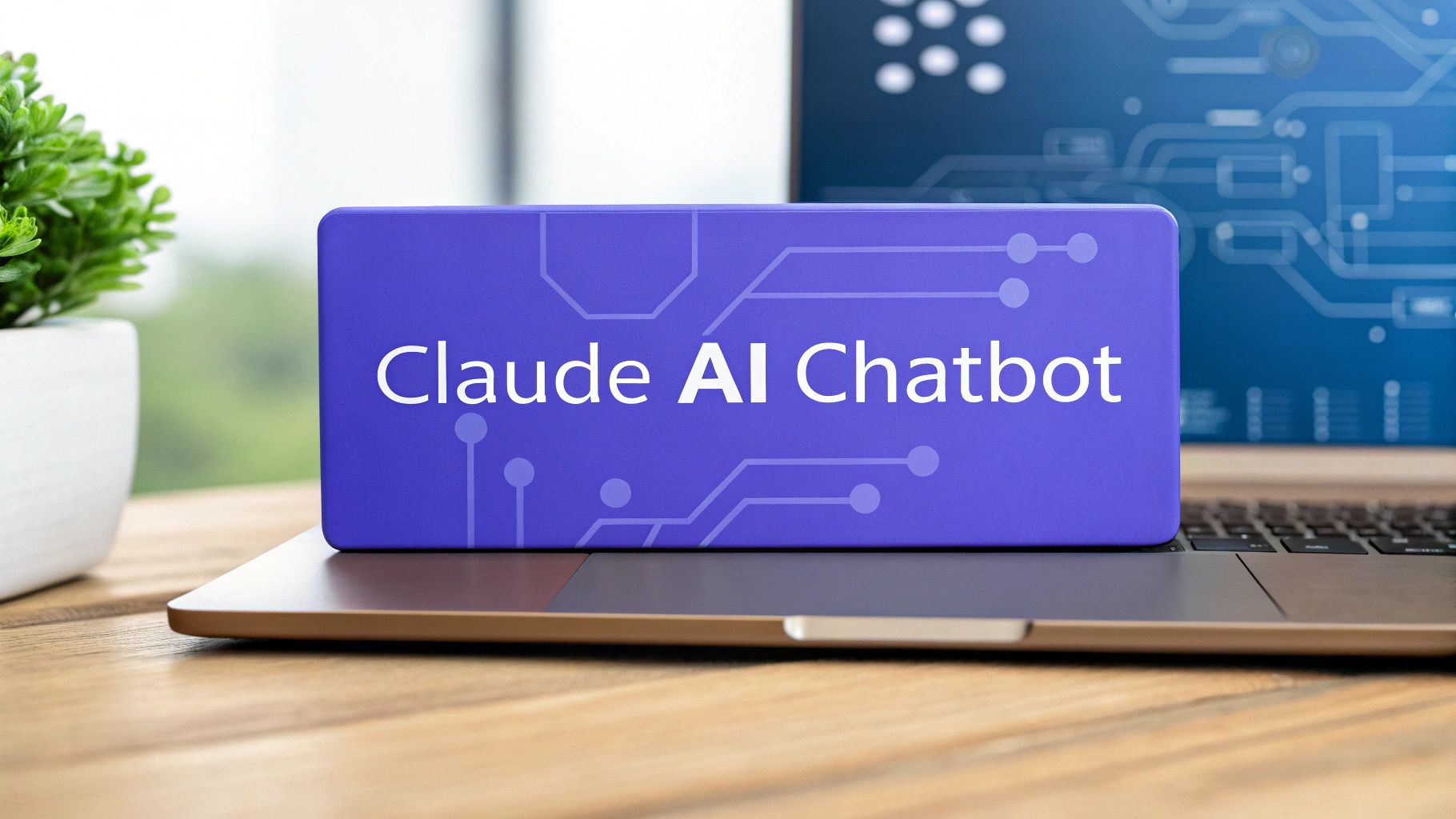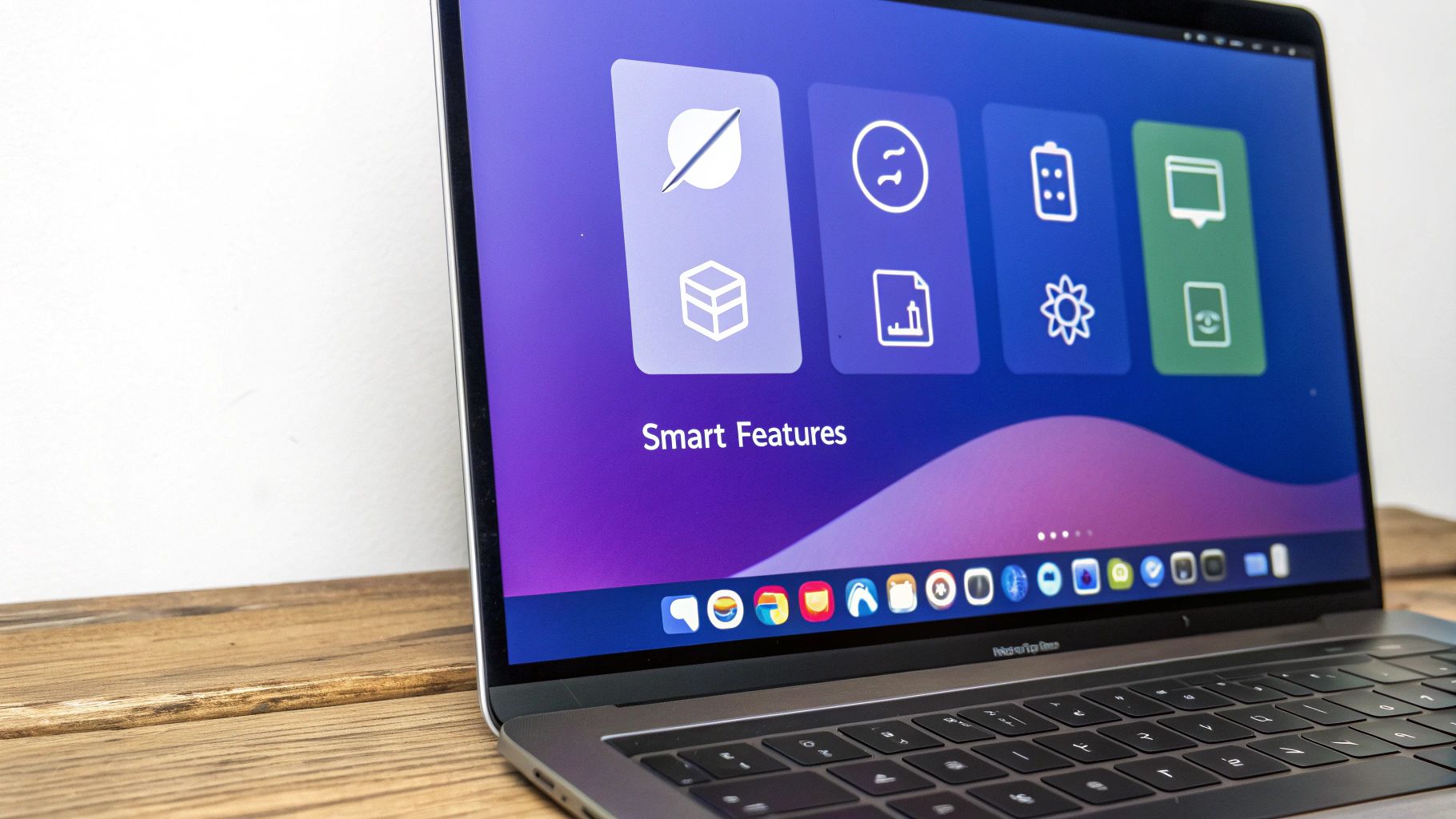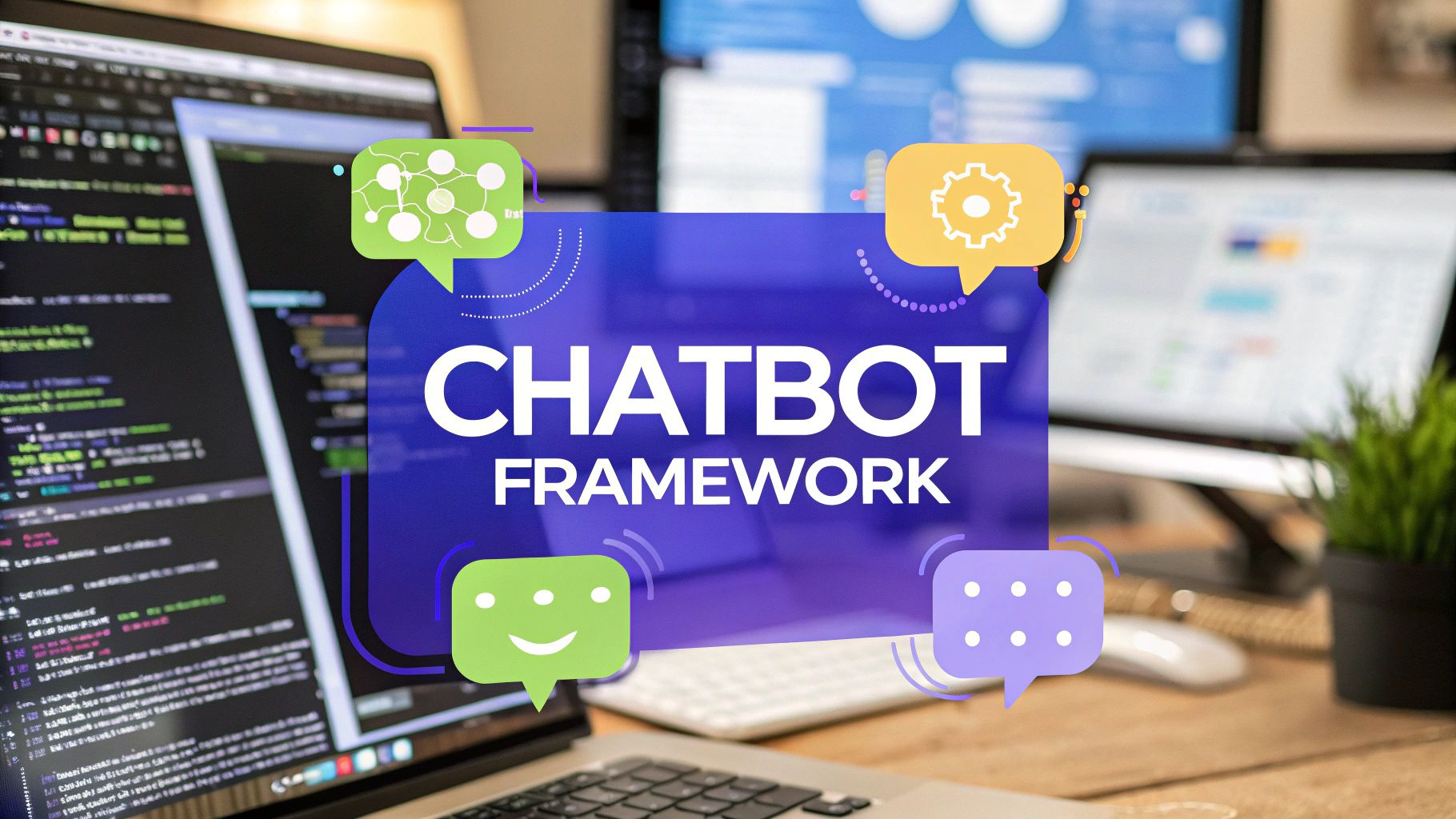What Is the Claude AI Chatbot and How Does It Work?
Explore the Claude AI chatbot from Anthropic. This guide covers what makes Claude different, its key features, how it works, and its real-world applications.

The Claude AI chatbot, developed by Anthropic, is a conversational AI built with a very specific goal: to be helpful, harmless, and honest. Think of it as a highly capable assistant for tasks like analysis, writing, and problem-solving, but one that stands apart because of its built-in ethical framework.
What Makes the Claude AI Chatbot Different?
It's easy to lump all AI assistants together, but the Claude AI chatbot isn't just another digital helper. It’s more like a specialized research partner with a conscience. While many AI models chase raw capability above all else, Claude is built on a foundation of safety and alignment with human values.
This unique approach comes directly from its developer, Anthropic, which was founded in 2021 by former OpenAI researchers. The company's laser focus on AI ethics has attracted major backing from tech giants like Amazon and Google. This support has fueled incredible growth, with Claude hitting over 54.4 million monthly website visits in 2024 and racking up more than 4.7 million app downloads in just six months.
The founders' commitment to safety isn't just a mission statement; it's a core reason for its impressive adoption. You can get more insights on Claude AI's rapid growth and its market impact in our detailed overview.
This screenshot from Anthropic's website really drives home their mission to build reliable and steerable AI systems.

The message is clear: build AI responsibly. That philosophy is baked directly into how the Claude AI chatbot operates every time you use it.
To give you a quick snapshot, here’s a high-level look at Claude’s core attributes.
Claude AI at a Glance
This table shows how Claude is positioned not just as a tool, but as a trustworthy partner designed for safe and productive use.
Core Guiding Principles
Claude’s behavior is shaped by a few key principles that set it apart from other models. These aren't just buzzwords; they are the rules that ensure its outputs are consistently reliable and safe.
- Helpful: Claude's main goal is to provide useful, relevant, and accurate information to help you get things done.
- Harmless: The AI is trained to actively avoid generating harmful, unethical, biased, or dangerous content. It’s designed to refuse inappropriate requests.
- Honest: It’s programmed to be truthful. If Claude doesn't know something, it’s supposed to say so rather than making up an answer.
This foundation is what allows Claude to tackle complex requests while minimizing the risks often associated with powerful AI. It’s about creating a tool you can depend on.
How Claude's Unique Architecture Works
To really get what makes the Claude AI chatbot different, we need to peek under the hood at its architecture. Many AI models are trained on massive internet datasets and then tweaked with human feedback to get better. Claude, on the other hand, is built on a totally different foundation called Constitutional AI. This approach is at the very core of how it behaves, making sure it stays helpful and harmless by design.
Imagine an AI that, before it gives you an answer, has to check its own work against a written constitution. This isn't just a loose guideline; it's a set of hard-coded ethical rules and principles—things like promoting positive values and steering clear of harmful content—that govern every single response. This built-in "conscience" lets the AI correct itself without needing a human to step in and micromanage every scenario.
The Power of Constitutional AI
This constitutional method is a two-step process that truly sets Claude apart. First, the model is trained to critique and rewrite its own responses based on the principles in its constitution. Then, this self-corrected data is used to fine-tune the AI, essentially teaching it to think and act based on helpful and harmless principles from the get-go.
Thanks to this built-in ethical framework, when you talk to the Claude AI chatbot, you're interacting with a system engineered for safety and alignment with human values. It actively avoids generating toxic, biased, or dangerous content, which makes it a much more reliable tool for both professional and personal use. This proactive safety is a big reason why so many businesses trust Claude with important tasks.
"The core idea is to train AI systems to operate within a set of principles, much like a national constitution guides a country’s laws. This allows the AI to supervise itself, scaling safety and alignment in a way that’s difficult to achieve with human oversight alone."
Mastering Conversations with a Large Context Window
Beyond its ethical backbone, Claude has another powerhouse feature: an exceptionally large context window. You can think of a context window as the AI's short-term memory. The bigger the window, the more information it can hold and process in a single conversation.
Lots of chatbots, for example, tend to forget what you said at the beginning of a long chat. They might lose track of key instructions or get sidetracked from the main point. Claude, however, can handle a massive amount of text—we're talking the equivalent of an entire book—all in one go.
This diagram gives you a simple look at how a query gets processed.

As the visual shows, the AI’s analysis is what turns a user's prompt into a genuinely useful response, and its huge memory makes that process far more powerful.
This feature has some serious real-world advantages:
- Document Analysis: You can upload a dense research paper, a long financial report, or a complex legal contract and ask Claude to summarize it, pull out key insights, or answer specific questions about what's inside.
- Complex Problem-Solving: For developers, this means Claude can analyze an entire codebase to hunt for bugs or suggest improvements without ever losing the plot.
- Coherent Content Creation: When you're writing long-form content, Claude can maintain a consistent tone, style, and narrative from the first sentence to the last.
In the end, it’s this blend of Constitutional AI and a massive context window that makes the Claude AI chatbot so effective. It’s not just smart; it’s principled, coherent, and ready to tackle complex, real-world tasks with impressive consistency.
Exploring Claude’s Core Capabilities
So, what can Claude actually do?
Beyond the technical architecture, Claude has a powerful set of skills that make it a seriously versatile partner for complex analysis, creative work, and deep problem-solving. It’s not just about asking a question and getting an answer; it’s about having a tool that can genuinely help you think through tough problems.
At its core, Claude is brilliant at understanding natural language. It can read, interpret, and pull together insights from huge amounts of text with a surprising level of nuance. This isn't just keyword matching—it's about getting the context, tone, and what’s really being said. This is the foundation that makes it so good at turning messy, unstructured information into clear, organized insights.
Advanced Analysis and Summarization
One of Claude's most powerful abilities is digesting and analyzing dense documents.
Imagine you’re handed a 100-page financial report packed with charts and jargon. Instead of blocking out your afternoon to read it, you could give it to Claude and ask it to flag the top three financial risks, complete with a brief explanation for each. Suddenly, hours of work become a few minutes of focused review.
This works for all sorts of challenging material:
- Legal Documents: Ask it to summarize the key obligations and liabilities in a long, dense service agreement.
- Academic Research: Have it distill the main findings and methodology from a complicated scientific paper.
- Meeting Transcripts: Feed it a long conversation and ask for a concise summary with clear, actionable next steps.
This capability is a game-changer, freeing you up from tedious manual review to focus on bigger-picture strategy.
Creative and Technical Content Generation
The Claude AI chatbot is also a powerful assistant for creating content. Whether you're a marketer trying to dream up a new campaign or a developer writing documentation, Claude can give you a solid head start.
For instance, a marketing team could give it a single product idea and get back five potential campaign slogans, a short blog post outline, and three social media posts.

But it's not just for marketers. Developers can ask Claude to generate boilerplate code in different programming languages, write clear technical documentation for an API, or even help refactor existing code to make it more readable and efficient.
One of Claude's standout features is its capacity to process and reason over entire books or complex codebases. This allows it to maintain context and consistency on a scale that many other models struggle with, making it invaluable for large-scale projects.
This impressive performance has earned it serious trust and widespread adoption. Data from mid-2025 shows just how much influence Claude is gaining, with its benchmark average response accuracy hitting a leading 98.3%. User satisfaction ratings have also climbed to 92%, and the AI now integrates with over 6,000 enterprise applications—including major platforms like Salesforce and Slack—proving its reliability and real-world value. You can find more statistics about Claude's position in the AI market on SQ Magazine.
These abilities, from deep analysis to creative generation, make the Claude AI chatbot an adaptable and potent tool. It’s built not just to answer questions, but to help you solve real-world problems more effectively.
Theory is one thing, but where the rubber meets the road is what really matters. For any new technology, the true test is its impact in the real world. Across different industries, the Claude AI chatbot is quickly moving from a cool concept to a must-have tool, solving specific, tangible problems every day.
From legal offices to software startups, professionals are putting Claude's sharp analytical and content creation skills to work, making complex jobs a lot simpler and more efficient. Think of it as a specialized assistant that learns the unique language and hurdles of different fields. A lawyer doesn't need the same kind of help as a software developer, and Claude is flexible enough to deliver for both.
This isn't just a niche trend. The growth has been explosive. After launching in March 2023, the platform saw a massive wave of new users. By January 2025, Claude app downloads had skyrocketed to roughly 769.6 million, with around 18.9 million people using it every month. The United States and India are at the forefront of this wave, accounting for over 33% of its global user base. You can dig into more of Claude's impressive user statistics on Backlinko.
Boosting Professional Productivity
In specialized fields, Claude’s ability to chew through huge amounts of text with incredible accuracy is a game-changer. It helps professionals cut through the noise and get back to doing the high-value work they were hired for.
- Legal Contract Analysis: A paralegal can upload a 200-page vendor contract and simply ask Claude to pull out all non-standard liability clauses, neatly summarizing them in a table. A task that once took hours of painstaking review is now done in minutes.
- Healthcare Research Synthesis: A medical researcher can feed Claude dozens of clinical trial papers on a new treatment. The chatbot can then spit out a concise summary of the key findings, methodologies, and even conflicting results, dramatically speeding up the literature review process.
- Customer Support Automation: While it won’t replace your human agents, Claude can be trained on a company's knowledge base to handle those first-line customer questions. For a deeper dive, check out our guide on how an AI chatbot for customer service can transform your support desk.
The real power of the Claude AI chatbot isn’t just that it processes information. It’s that it structures that information in a way that helps professionals make better decisions. It turns a mountain of raw data into intelligence you can actually use.
Empowering Education and Development
It’s not just about traditional business roles. Claude is also making a huge difference in education and software development, where it helps people learn and build things more effectively.
For students, it can act as a personal tutor available 24/7. A history student struggling with a complex event can ask Claude to explain it from multiple viewpoints or create a study guide with key dates and figures. It offers a much more dynamic and interactive way to learn.
In the world of software development, the Claude AI chatbot is like having an invaluable coding partner on standby. A developer wrestling with a stubborn bug can paste their code and ask Claude to spot potential errors. It can also help draft clear and complete technical documentation—a task that almost always slows projects down. These practical uses show how Claude closes the gap between powerful technology and solving everyday problems.
Benefits of Using Claude in Your Workflow
Bringing the Claude AI chatbot into your professional life isn't just about convenience. It’s a strategic move to reclaim your time, sharpen your thinking, and unlock your creative side. Think of it as a way to fundamentally change how you work by automating the tedious stuff and amplifying your own strengths.
The most immediate benefit is a massive productivity boost. Repetitive, mind-numbing tasks like sifting through long documents, transcribing meeting notes, or drafting initial emails can be handed off to Claude. This is about more than just working faster; it’s about freeing up your mental energy for the high-impact work that actually requires human insight and strategy.

Improve Strategic Decision-Making
Beyond simple efficiency, the Claude AI chatbot is a master at synthesis, turning huge piles of information into clear, actionable intelligence. This is a game-changer for making better, more informed decisions. Its large context window allows it to chew through complex datasets, lengthy reports, and multiple sources at once without losing the thread.
For instance, a business leader could feed Claude quarterly performance reports from several departments and ask it to flag cross-functional trends and potential risks. Claude can connect dots that a human might miss in a manual, siloed review, giving you a much clearer, more holistic view of the business landscape.
This leads to a few key advantages:
- Deeper Insights: Uncover subtle patterns and correlations in data that would be almost impossible to spot by hand.
- Reduced Bias: By focusing on data-driven summaries, Claude helps minimize the influence of personal opinions or gut feelings in the decision-making process.
- Faster Analysis: Get the vital information you need in minutes, not days. This means you can be far more agile and responsive with your strategies.
Unlock and Accelerate Creativity
Finally, Claude is an incredible brainstorming partner, perfect for breaking through creative blocks and exploring new territory. Whether you're a marketer dreaming up a campaign, a writer outlining a story, or a developer designing a new feature, Claude can act as a tireless collaborator. It never runs out of steam and always has a fresh perspective to offer.
Think of Claude as a creative catalyst. It provides the initial spark or the alternative angle you need to get past a mental hurdle, helping you go from a blank page to a solid plan with speed and confidence.
You could give it a simple concept and ask for multiple creative directions, target audience personas, or even sample ad copy. This process doesn't replace human creativity—it supercharges it. The Claude AI chatbot does the initial heavy lifting of idea generation, which frees you up to focus on what you do best: refining, curating, and executing the winning concepts.
Diving into a new AI tool can feel a bit overwhelming, but getting started with the Claude AI chatbot is refreshingly simple. This guide will walk you through the first few steps, from signing up to writing prompts that actually get you the results you’re looking for.
First things first, you'll need an account. The signup is quick—all you need is an email or a Google account to get authenticated. Once you’re in, you’ll land on a clean, minimalist interface that’s designed to get you chatting with the AI right away.
The main screen is dominated by a text box where you can kick off your first conversation. Here's a peek at the uncluttered design.
This simple layout is completely intentional. It keeps your focus on what matters most: the dialogue between you and the chatbot.
A Mini-Guide to Writing Better Prompts
The quality of what you get out of Claude depends entirely on what you put in. It helps to think of it less like a search engine and more like a very capable assistant. The more context and clarity you give it, the better your results will be.
Here are a few quick tips to level up your prompts:
- Give It Clear Context: Instead of just asking, "Summarize this," try something like, "Summarize this financial report for an executive audience, focusing on key revenue drivers and potential risks."
- Tell It What Format You Want: Be specific. You can ask for a bulleted list, a table, a draft email, or even a block of code.
- Assign It a Persona: Give Claude a role to play. For example, "Act as an expert copywriter and create three headlines for an ad about sustainable coffee."
The real key to effective prompting is shifting your mindset from asking simple questions to giving detailed instructions. When you give Claude a role, context, and a desired format, you're guiding it toward a much more useful and tailored response.
Choosing the Right Claude Model for Your Needs
Anthropic offers a few different versions of Claude, each designed for different tasks. Knowing which one to use can save you time and money, while making sure you get the right balance of speed and intelligence.
Here’s a quick breakdown to help you decide.
Think of Haiku as your go-to for speed, Opus for brainpower, and Sonnet as the perfect blend of both. Picking the right one ensures you're not overpaying for simple queries or underpowering a complex job.
Mastering these simple techniques will make a huge difference in your experience with the Claude AI chatbot. For a more detailed walkthrough, feel free to explore our full guide on getting started with AI assistants to build your skills even further. The best way to learn, though, is to just jump in and experiment. Try different prompting styles to see what works best for you.
Unpacking Claude AI: Your Questions Answered
As you start working with Claude AI, you’ll naturally have questions. Is it safe? How is my data used? What’s the real difference between the models? Getting straight answers to these things is key to feeling confident with the tool.
Let’s tackle some of the most common questions that pop up.
One of the first things people want to know is about data privacy. Anthropic draws a clear line here: they do not train their commercial models on any data you submit through their API. Your business data stays your own.
For the free consumer version at claude.ai, conversations can be used for training, but you can easily opt out in your account settings if you’d rather keep them private. It's a sensible approach that balances improving the AI with respecting user privacy.
Another frequent point of confusion is the difference between the Claude models—Haiku, Sonnet, and Opus. It helps to think of them as different tools for different jobs.
Is Claude safe to use? Yes, absolutely. It was built from the ground up with safety in mind. Its “Constitutional AI” framework is designed to steer it away from harmful, biased, or sketchy responses, making it one of the more reliable chatbots out there.
What is the best model for creative writing? If you're tackling something that needs serious creative muscle, Opus is your go-to. It has the most advanced reasoning and a knack for nuance. For everyday writing, however, Sonnet hits a great sweet spot between creative flair and speed.
The big takeaway is that Claude isn't just one thing; it's a family of models. Picking the right one—speedy Haiku, well-rounded Sonnet, or powerhouse Opus—is how you get the best results, whether you're just summarizing an article or running complex analysis. This flexibility is what makes the Claude platform so powerful.
Ready to see what an AI assistant can do for your team? With Chatiant, you can build a custom chatbot trained on your own data, helping your sales, operations, and success teams work smarter. Create your first AI agent today.


